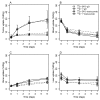Evaluation of a 3-hydroxypyridin-2-one (2,3-HOPO) Based Macrocyclic Chelator for (89)Zr(4+) and Its Use for ImmunoPET Imaging of HER2 Positive Model of Ovarian Carcinoma in Mice
- PMID: 26941844
- PMCID: PMC4775861
- DOI: 10.7150/thno.14261
Evaluation of a 3-hydroxypyridin-2-one (2,3-HOPO) Based Macrocyclic Chelator for (89)Zr(4+) and Its Use for ImmunoPET Imaging of HER2 Positive Model of Ovarian Carcinoma in Mice
Abstract
A novel octadentate 3-hydroxypyridin-2-one (2,3-HOPO) based di-macrocyclic ligand was evaluated for chelation of (89)Zr; subsequently, it was used as a bi-functional chelator for preparation of (89)Zr-labeled antibodies. Quantitative chelation of (89)Zr(4+) with the octadentate ligand forming (89)ZrL complex was achieved under mild conditions within 15 minutes. The (89)Zr-complex was stable in vitro in presence of DTPA, but a slow degradation was observed in serum. In vivo, the hydrophilic (89)Zr-complex showed prevalently renal excretion; and an elevated bone uptake of radioactivity suggested a partial release of (89)Zr(4+) from the complex. The 2,3-HOPO based ligand was conjugated to the monoclonal antibodies, HER2-specific trastuzumab and an isotypic anti-gD antibody, using a p-phenylene bis-isothiocyanate linker to yield products with an average loading of less than 2 chelates per antibody. Conjugated antibodies were labeled with (89)Zr under mild conditions providing the PET tracers in 60-69% yield. Despite the limited stability in mouse serum; the PET tracers performed very well in vivo. The PET imaging in mouse model of HER2 positive ovarian carcinoma showed tumor uptake of (89)Zr-trastuzumab (29.2 ± 12.9 %ID/g) indistinguishable (p = 0.488) from the uptake of positive control (89)Zr-DFO-trastuzumab (26.1 ± 3.3 %ID/g). In conclusion, the newly developed 3-hydroxypyridin-2-one based di-macrocyclic chelator provides a viable alternative to DFO-based heterobifunctional ligands for preparation of (89)Zr-labeled monoclonal antibodies for immunoPET studies.
Keywords: 2; 3-HOPO; 3-hydroxypyridin-2-one.; 89Zr; imaging; immunoPET; monoclonal antibody; positron emission tomography; radiolabeling.
Conflict of interest statement
Competing Interests: D. Magda and S. Pailloux are employees of Lumiphore, Inc., a company developing bi-functional metal chelators for commercial applications.
Other authors have declared that no competing interest exists.
Figures



Similar articles
-
p-SCN-Bn-HOPO: A Superior Bifunctional Chelator for (89)Zr ImmunoPET.Bioconjug Chem. 2015 Dec 16;26(12):2579-91. doi: 10.1021/acs.bioconjchem.5b00572. Epub 2015 Nov 25. Bioconjug Chem. 2015. PMID: 26550847 Free PMC article.
-
Comparison of the octadentate bifunctional chelator DFO*-pPhe-NCS and the clinically used hexadentate bifunctional chelator DFO-pPhe-NCS for 89Zr-immuno-PET.Eur J Nucl Med Mol Imaging. 2017 Feb;44(2):286-295. doi: 10.1007/s00259-016-3499-x. Epub 2016 Aug 30. Eur J Nucl Med Mol Imaging. 2017. PMID: 27573793 Free PMC article.
-
Alternative chelator for ⁸⁹Zr radiopharmaceuticals: radiolabeling and evaluation of 3,4,3-(LI-1,2-HOPO).J Med Chem. 2014 Jun 12;57(11):4849-60. doi: 10.1021/jm500389b. Epub 2014 May 19. J Med Chem. 2014. PMID: 24814511 Free PMC article.
-
89Zr-Immuno-Positron Emission Tomography in Oncology: State-of-the-Art 89Zr Radiochemistry.Bioconjug Chem. 2017 Sep 20;28(9):2211-2223. doi: 10.1021/acs.bioconjchem.7b00325. Epub 2017 Aug 24. Bioconjug Chem. 2017. PMID: 28767228 Free PMC article. Review.
-
Recent Advances in Zirconium-89 Chelator Development.Molecules. 2018 Mar 12;23(3):638. doi: 10.3390/molecules23030638. Molecules. 2018. PMID: 29534538 Free PMC article. Review.
Cited by
-
PET Imaging of Receptor Tyrosine Kinases in Cancer.Mol Cancer Ther. 2018 Aug;17(8):1625-1636. doi: 10.1158/1535-7163.MCT-18-0087. Mol Cancer Ther. 2018. PMID: 30068751 Free PMC article. Review.
-
Polyazamacrocycle Ligands Facilitate 89Zr Radiochemistry and Yield 89Zr Complexes with Remarkable Stability.Inorg Chem. 2020 Dec 7;59(23):17473-17487. doi: 10.1021/acs.inorgchem.0c02722. Epub 2020 Nov 10. Inorg Chem. 2020. PMID: 33169605 Free PMC article.
-
Hydroxypyridinones as a Very Promising Platform for Targeted Diagnostic and Therapeutic Radiopharmaceuticals.Molecules. 2021 Nov 19;26(22):6997. doi: 10.3390/molecules26226997. Molecules. 2021. PMID: 34834087 Free PMC article. Review.
-
Direct comparison of the in vitro and in vivo stability of DFO, DFO* and DFOcyclo* for 89Zr-immunoPET.Eur J Nucl Med Mol Imaging. 2019 Aug;46(9):1966-1977. doi: 10.1007/s00259-019-04343-2. Epub 2019 Jun 3. Eur J Nucl Med Mol Imaging. 2019. PMID: 31161258 Free PMC article.
-
Zirconium tetraazamacrocycle complexes display extraordinary stability and provide a new strategy for zirconium-89-based radiopharmaceutical development.Chem Sci. 2017 Mar 1;8(3):2309-2314. doi: 10.1039/c6sc04128k. Epub 2016 Dec 13. Chem Sci. 2017. PMID: 28451334 Free PMC article.
References
-
- van Dongen GA, Visser GW, Lub-de Hooge MN, de Vries EG, Perk LR. Immuno-PET: a navigator in monoclonal antibody development and applications. The oncologist. 2007;12:1379–89. - PubMed
-
- Marik J, Junutula JR. Emerging role of immunoPET in receptor targeted cancer therapy. Current drug delivery. 2011;8:70–8. - PubMed
-
- Tinianow JN, Gill HS, Ogasawara A, Flores JE, Vanderbilt AN, Luis E. et al. Site-specifically 89Zr-labeled monoclonal antibodies for ImmunoPET. Nuclear medicine and biology. 2010;37:289–97. - PubMed
-
- Perk LR, Vosjan MJ, Visser GW, Budde M, Jurek P, Kiefer GE. et al. p-Isothiocyanatobenzyl-desferrioxamine: a new bifunctional chelate for facile radiolabeling of monoclonal antibodies with zirconium-89 for immuno-PET imaging. European journal of nuclear medicine and molecular imaging. 2010;37:250–9. - PMC - PubMed
Publication types
MeSH terms
Substances
LinkOut - more resources
Full Text Sources
Other Literature Sources
Medical
Research Materials
Miscellaneous

